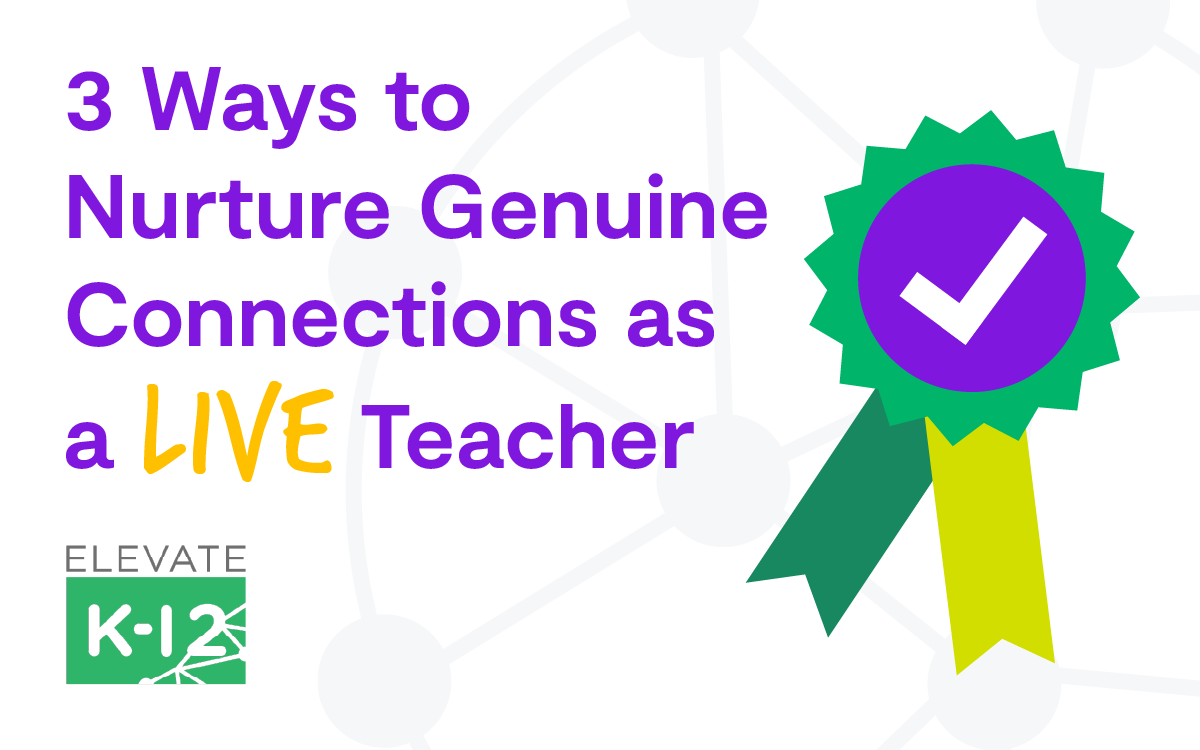In the ever-evolving landscape of education, the shift toward online teaching has become a defining feature of our time. As educators adapt to this digital model, the challenge of forging authentic connections with students has taken center stage. While the virtual realm may seem like an impediment to meaningful relationships, I’ve found it can be a powerful platform for fostering genuine connections.
Drawing from my 15 years of teaching experience, I’ve witnessed firsthand the transformative impact of online teaching in motivating, facilitating, and engaging students. However, it’s imperative that educators employ the right methods and strategies to effectively support students in their online learning journey. As I enter my fifth year of LIVE teaching with Elevate K-12, I’m excited to share some of the most successful approaches I’ve discovered for cultivating genuine connections with my students.
3 Strategies for Fostering Authentic Classroom Relationships as a LIVE Teacher
Let’s explore the three transformative ways I cultivate authentic connections with my students during LIVE teaching in my Elevate K-12 classroom.
1. Create a Welcoming Virtual Space
The foundation of any meaningful connection is a sense of belonging and comfort. In a physical classroom, the physical space sets the atmosphere – the desks or lack thereof, the walls adorned with student work, the teacher’s desk. In the virtual realm, the equivalent is the digital space you create for your students.
At Elevate K-12, we have a start-of-class routine that facilitates this foundation. I start by creating a well-thought-out welcome board that is fun, personalized, with clear expectations for our day, and a visual reflection of my personality and values. This gives students a glimpse into the person behind the screen.
Interactive elements such as do-now activities, icebreakers, polls, and class chats allow students to express themselves in a more relaxed setting. It also injects clear expectations and a productive, predictable way to start class and keep students on task.
Sharing fun facts about myself and encouraging students to do the same fosters a sense of camaraderie. During my Elevate Live sessions, I allocate time for casual conversations, allowing students to ask questions or share information unrelated to the curriculum.
The Elevate K-12 platform has features designed to facilitate natural and engaging conversations. One notable feature is private chat, which allows students who may be hesitant to express themselves in a public setting an alternative avenue for participation. This level of engagement during a lesson transcends the possibilities in a traditional classroom setting, underscoring the capacity of virtual tools to elevate and enhance overall class engagement.
By accommodating diverse comfort levels, these features ensure that every student can actively participate in a manner aligned with their individual preferences, contributing to a more inclusive and dynamic learning environment.
2. Utilize Technology for Personalized Engagement
Technology can be seen as a barrier to human connection; here at Elevate K-12, we believe it can be a powerful tool for enhancing engagement and personalization. In my live sessions, I can leverage various technological features to create a more personalized learning environment.
One of the key strategies is incorporating multimedia elements. Instead of relying solely on text-based communication, I use video messages to provide feedback or deliver important announcements. This adds a personal touch, allowing students to see and hear me, reinforcing the human connection. Utilizing our research-backed curriculum alongside 3rd party tools gives teachers the creative flexibility to deliver content taking different learning styles into account.
Additionally, I encourage students to create and share multimedia presentations, fostering imagination and individual expression. Our top-notch curriculum writers have taken the guesswork out of objectives and state standards, allowing me to focus on teaching and engagement strategies.
3. Build a Collaborative Learning Community
Fostering a collaborative learning community among students is crucial for creating a dynamic online classroom. In a collaborative learning community, students are not only active participants in their own educational journey, but play a pivotal role in shaping the educational experiences of their peers. By actively cultivating collaboration, I ensure students connect with me and their peers.
So, what constitutes a collaborative learning community? It goes beyond just group work and partner projects. In my experience, implementing peer feedback and peer review mechanisms adds an extra layer of connectivity. Constructive feedback and insight enhance the learning experience while strengthening the bond between students. This approach promotes a sense of community and shared learning, fostering a sense of responsibility for each other’s success. But beyond that, it equips students with practical collegiate and professional skills.
While I recognize that this collaborative technique is not exclusive to Elevate K-12 and has proven effective in traditional, in-person settings, what sets us apart is the Elevate platform’s capacity to offer students diverse ways to interact with both me and their peers. These multidimensional engagement opportunities unlock collaboration possibilities that go beyond the confines of a traditional classroom.
Conclusion
In navigating the challenges of online or virtual teaching, skepticism about its ability to foster connections is natural. However, learning experiences like Elevate K-12 LIVE show that technology can unlock profound connections between students and teachers. The key lies with the teacher. By adopting the best practices I’ve outlined above, educators can not only bridge the gap between the virtual and physical classroom but also elevate connectivity to new heights. Ultimately, students will experience heightened feelings of value, motivation, and connection, leading them to greater success.
About the Author: Monica Vaesa is a dedicated educator from Texas with over 15 years of teaching experience across traditional brick-and-mortar schools and e-learning platforms. Currently in her fifth year of LIVE teaching with Elevate, Monica leverages her extensive experience to unlock every student’s exponential learning potential.

